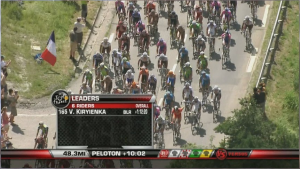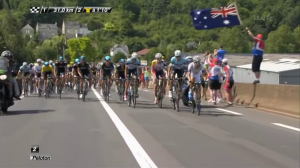While July is a great month for long bike rides in Minnesota, I find myself dedicated to much more “couch time” than usual. My July obsession: Le Tour, the Tour de France, the big old race around France (or whatever you’d like to call it). While I consider myself the very opposite of the lycra clad, weight obsessed (both in body and machine), Skittle-colored hard-core roadie – I find the tour fascinating. The team dynamic, the strategies, and the torturous rides, climbs and descents. And then there’s the gloomy overshadow of drug use, hushed amongst the announcers, hoping they won’t alienate their audience. Drama, speed, egos, color. So how do follow it?
My first rule goes against the grain of a true fan: I never watch the tour in real-time, except maybe for the last stage, which is really more of a victory ride than anything. I follow this rule for several reasons. I don’t need to be on the couch any more than I am. I’m also not going to pay for my cable provider’s sports package to get poor live coverage of an event that happens once a year. The US broadcasters will needlessly focus on any Americans in the race who (spoiler alert) aren’t going to win. Plus, cycling is an obscure sport, so there’s little risk of actual race spoilers – you can temporarily unfollow your bike race friends on twitter for complete isolation.
Instead I recommend downloading the one hour race highlights the day after. The best coverage I’ve found is the British ITV highlights show. They boil a full day of racing down to one hour of coverage (45 minutes without commercials) which only includes the most exciting parts. Plus they have great segments with great music. Yes, they have a little bit of a British slant, but it’s been well served the last few years with Bradley Wiggins and Chris Froome on the podium. Moreover, I think they simply understand cycling more.
TdF coverage comparison
On most English speaking broadcasts, you get Phil Liggett and Paul Sherwen. Some people take pleasure from (or get annoyed by) these guys for being cliché and/or tripping over their words, but they’re the ones blabbing all day, trying to keep the dull parts exciting. I give them a pass due to their experience, but then again I also liked John Madden as a football commentator.
It’s the visual “enhancements” the US broadcasters add that irk me. When Versus picked up coverage a few years ago, it was especially bad. They had this hideous ticker constantly scrolling at the bottom. What is this, NASCAR or Fox News?

ITV uses the host broadcast (French) feed and doesn’t muddle it up any further. It’s clear what’s going on. They have little icons for the jerseys so you know what group they’re in if there’s been a breakaway. And they’ll tell you how much time is between the group(s).

The French know how to cover the race. They’ve been doing it for over 100 years. From the upper left of this screen I know that the leader is 31km from the finish of the stage. The wearer of the yellow jersey is in the main group of riders, called the peloton, which is 2nd to the breakaway group (or rider) in front. The peloton is 1 minute 10 seconds back from the group out front.
From the lower left I know that on screen is the peloton (again the 2nd group). If we were watching the front group it would say “1 – Tete de la course” (head of the course). I promise you won’t need your French/English dictionary. Very little gets lost in translation.
The Jerseys
Yellow Jersey
Overall race leader. The winner of the first stage will be the first to wear the yellow jersey or maillot jaune. But every stage time gets added together as the race continues. The big factor here is the gap. If riders cross the finish line as a group (with wheels overlapping), they all get the same time. So even if the main group is stretched out a quarter mile long, they all get the same time as the first front wheel to cross the finish line. Once there is a gap in riders, time gets added.
Green Jersey
The sprinters jersey, also referred to as the points jersey. This jersey is worn by the rider accumulating the most points awarded by winning intermediate sprints (checkpoints that occur mid-stage, usually in a flat section) and at the finish line if it’s in a flat section. I’m not exactly sure why they call it the points classification as the polka dot jersey also uses points.
Polka Dot Jersey
The polka dot jersey is also know as the King Of The Mountains (KOM) jersey. Like the green jersey, points are awarded to riders arriving first at the summit of a mid-stage climb, or a finish line that ends at a mountain peak. The polka-dot color, introduced in 1975 came from chocolate maker and then sponsor Chocolat Poulain (their chocolate bars were adorned in a polka-dot wrapper).
White Jersey
The white jersey is for the best young rider. It’s really like the yellow jersey for riders age 25 and under – based on their total time.
Rainbow Jersey
The rainbow jersey (really a white jersey with rainbow stripes around the middle), is worn by the World Champion in road racing. While not directly part of the Tour de France points or time competition, the reigning World Champion is required to wear it at all races, or else pay a penalty enforced by the International Cycling Union (UCI). Since there are several categories within the road race categories (Road Race, Time Trial, Team Time Trial) the wearer of the rainbow jersey on a normal stage may be different than on a time trial stage.
What if a rider is winning in two categories?
The above jerseys are listed in order of their prestigious-ness. If a single rider actually lays claim to more than one jersey, he will wear the more prestigious one during the race, and the “abandoned” jersey will go to the 2nd place rider in that category.
Where do I start?
You can download shows via BitTorrent, there are several good clients out there like Transmission or μTorrent. Devices like WDTV Live or Roku work great for playing the downloads on your TV. The supreme omnipotent index for all shows cycling lives at Cycling Torrents. If it all seems to complicated, just come on over with a couple of beers (one for me please) and we can enjoy the abridged glory of Le Tour in style, plus we’ll still have time for a ride.
Leave a Reply